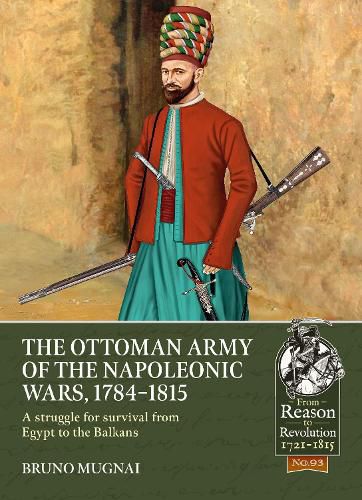Readings Newsletter
Become a Readings Member to make your shopping experience even easier.
Sign in or sign up for free!
You’re not far away from qualifying for FREE standard shipping within Australia
You’ve qualified for FREE standard shipping within Australia
The cart is loading…






The period 1792 1815 was a pivotal moment in world history, but many accounts lack detail about Ottoman military developments. The book examines changes and development of the Ottoman army from the Napoleonic Campaign in Egypt until the Serbian uprisings in 1804-13 and 1815. The Ottoman Empire was only marginally affected by the conflicts of the Napoleonic era; however, the period between the 1790s and 1820s was very important for the history and institutions of the multicultural state. Scholars working on the Ottomans in the Balkans, Anatolia, Egypt, and Syria have reached something of a consensus about these years as a watershed for the Ottomans. It was a moment when reform became necessary not just as a palace experiment, but as a matter of life and death for the dynasty and empire alike. Survival in the Ottoman dynastic context meant engaging in a series of multilateral negotiations, not only with foreign powers, but also with a host of new military, intellectual, and religious elite groups. These emerged precisely because of shrinking borders, mobile military forces, and refugee populations. The struggle for survival was central to the changing dynamics of Ottoman society, especially in a period when war was generally proving too costly in human and economic terms. The toll on local society was large, and also interested the territories of the empire which were not directly within the war zones. The book examines changes and development of the Ottoman army from the Napoleonic Campaign in Egypt until the Serbian uprisings in 1804-13 and 1815, also including a detailed description of dress and equipment of the Ottoman soldiers of this period. AUTHOR: Bruno Mugnai was born in Florence in 1962 and still lives there with Silvia, Chiara and Eugenio. Active for years as a divulger of history and illustrator, he has published several titles for publishers such as the Historical Office of the Italian Army and Helion & Company in the UK, concerning to the periods and geographical areas of his interest, as the Ancient Italian States, central and eastern Europe in 16th, 17th and 18th century and South America after the conquest. As an illustrator he is collaborating with important Italian and foreign specialists and with the Stibbert Museum of Florence. Bruno is a Rugby Football Union enthusiast, who is still trusting in the Italian Grand Slam in the Six Nations Tournament. 16 colour plates, 100 b/w images, pictures, diagrams & maps
$9.00 standard shipping within Australia
FREE standard shipping within Australia for orders over $100.00
Express & International shipping calculated at checkout
The period 1792 1815 was a pivotal moment in world history, but many accounts lack detail about Ottoman military developments. The book examines changes and development of the Ottoman army from the Napoleonic Campaign in Egypt until the Serbian uprisings in 1804-13 and 1815. The Ottoman Empire was only marginally affected by the conflicts of the Napoleonic era; however, the period between the 1790s and 1820s was very important for the history and institutions of the multicultural state. Scholars working on the Ottomans in the Balkans, Anatolia, Egypt, and Syria have reached something of a consensus about these years as a watershed for the Ottomans. It was a moment when reform became necessary not just as a palace experiment, but as a matter of life and death for the dynasty and empire alike. Survival in the Ottoman dynastic context meant engaging in a series of multilateral negotiations, not only with foreign powers, but also with a host of new military, intellectual, and religious elite groups. These emerged precisely because of shrinking borders, mobile military forces, and refugee populations. The struggle for survival was central to the changing dynamics of Ottoman society, especially in a period when war was generally proving too costly in human and economic terms. The toll on local society was large, and also interested the territories of the empire which were not directly within the war zones. The book examines changes and development of the Ottoman army from the Napoleonic Campaign in Egypt until the Serbian uprisings in 1804-13 and 1815, also including a detailed description of dress and equipment of the Ottoman soldiers of this period. AUTHOR: Bruno Mugnai was born in Florence in 1962 and still lives there with Silvia, Chiara and Eugenio. Active for years as a divulger of history and illustrator, he has published several titles for publishers such as the Historical Office of the Italian Army and Helion & Company in the UK, concerning to the periods and geographical areas of his interest, as the Ancient Italian States, central and eastern Europe in 16th, 17th and 18th century and South America after the conquest. As an illustrator he is collaborating with important Italian and foreign specialists and with the Stibbert Museum of Florence. Bruno is a Rugby Football Union enthusiast, who is still trusting in the Italian Grand Slam in the Six Nations Tournament. 16 colour plates, 100 b/w images, pictures, diagrams & maps